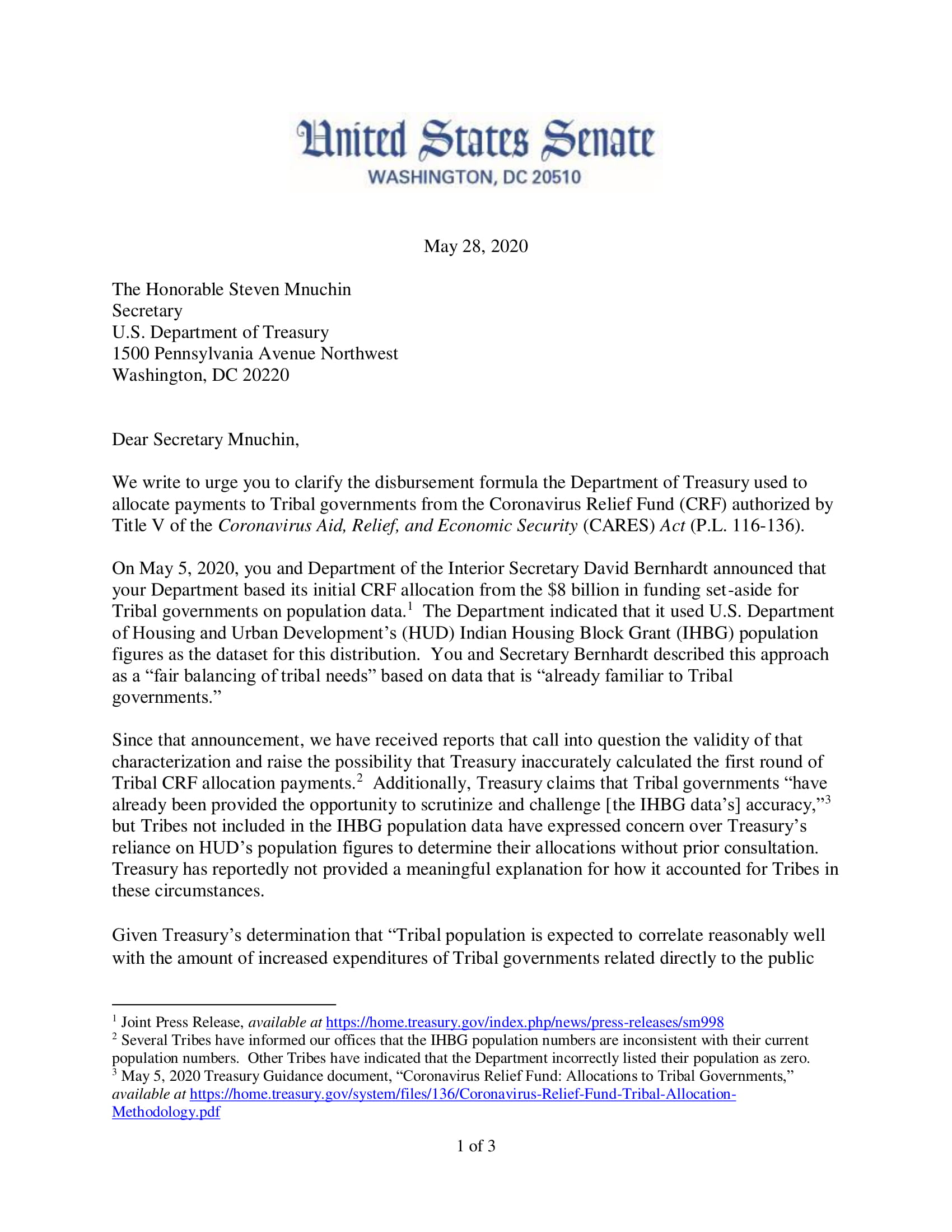FOR IMMEDIATE RELEASE: May 29, 2020
Udall, Democratic Senators Request Information About the Distribution of Coronavirus Relief Funds to Tribal Governments
Senators echo concerns raised by Tribes about Treasury’s use of HUD population figures to determine funding allocations without necessary consultation
WASHINGTON — U.S. Senator Tom Udall (D-N.M.) vice chairman of the Senate Committee on Indian Affairs, along with U.S. Senators John Tester (D-Mont.), Catherine Cortez Masto (D-Nev.), Martin Heinrich (D-N.M.), Tina Smith (D-Minn.), Ron Wyden (D-Ore.), Tammy Baldwin (D-Wisc.), Tammy Duckworth (D-Il.), Angus King (I-Maine), Elizabeth Warren (D-Mass.), Jacky Rosen (D-Nev.),and Michael Bennet (
In the letter the senators ask Secretary Mnuchin to respond to their information request
“On May 5, 2020, you and Department of the Interior Secretary David Bernhardt announced that your Department based its initial CRF allocation from the $8 billion in funding set-aside for Tribal governments on population data. The Department indicated that it used U.S. Department of Housing and Urban Development’s (HUD) Indian Housing Block Grant (IHBG) population figures as the dataset for this distribution,” wrote the senators. “You and Secretary Bernhardt described this approach as a ‘fair balancing of tribal needs’ based on data that is ‘already familiar to Tribal governments.’’
“Since that announcement, we have received reports that call into question the validity of that characterization and raise the possibility that Treasury inaccurately calculated the first round of Tribal CRF allocation payments,” continued the senators.
Moreover, Treasury has reportedly not provided a meaningful explanation for how it accounted for Tribes not included in IHBG population data and Tribes have expressed concerns over Treasury’s reliance on HUD’s population figures without prior consultation.
“Given Treasury’s determination that ‘Tribal population is expected to correlate reasonably well with the amount of increased expenditures of Tribal governments related directly to the public health emergency,’ it is critically important that the population numbers it relied on are as accurate as possible. While Treasury has provided Tribes an opportunity to review the underlying IHBG dataset, Treasury has not published any modifications to the dataset to allow Tribes affected by the issues above to provide feedback and correct any potential errors or inaccuracies,” the senators wrote.
The full letter can be found below and HERE.



Dear Secretary Mnuchin,
We write to urge you to clarify the disbursement formula the Department of Treasury used to allocate payments to Tribal governments from the Coronavirus Relief Fund (CRF) authorized by Title V of the Coronavirus Aid, Relief, and Economic Security (CARES) Act (P.L. 116-136).
On May 5, 2020, you and Department of the Interior Secretary David Bernhardt announced that your Department based its initial CRF allocation from the $8 billion in funding set-aside for Tribal governments on population data.[1] The Department indicated that it used U.S. Department of Housing and Urban Development’s (HUD) Indian Housing Block Grant (IHBG) population figures as the dataset for this distribution. You and Secretary Bernhardt described this approach as a “fair balancing of tribal needs” based on data that is “already familiar to Tribal governments.”
Since that announcement, we have received reports that call into question the validity of that characterization and raise the possibility that Treasury inaccurately calculated the first round of Tribal CRF allocation payments.[2] Additionally, Treasury claims that Tribal governments “have already been provided the opportunity to scrutinize and challenge [the IHBG data’s] accuracy,”[3] but Tribes not included in the IHBG population data have expressed concern over Treasury’s reliance on HUD’s population figures to determine their allocations without prior consultation. Treasury has reportedly not provided a meaningful explanation for how it accounted for Tribes in these circumstances.
Given Treasury’s determination that “Tribal population is expected to correlate reasonably well with the amount of increased expenditures of Tribal governments related directly to the public health emergency,”[4] it is critically important that the population numbers it relied on are as accurate as possible. While Treasury has provided Tribes an opportunity to review the underlying IHBG dataset, Treasury has not published any modifications to the dataset to allow Tribes affected by the issues above to provide feedback and correct any potential errors or inaccuracies.
We therefore ask you to provide us with a table of all Tribal allocations issued using the IHBG-based formula and an explanation of all IHBG dataset modifications or additions Treasury made. We urge you to provide this information expeditiously to ensure that this disbursement methodology is fully transparent and that all Tribes receive adequate funds to ensure the health and safety of their Tribal communities.
Thank you for your attention to this important matter. We look forward to working with you to continue to uphold the federal government’s Tribal trust and treaty responsibilities and government-to-government relations with Tribal governments regarding the response to the COVID-19 pandemic.
HHS Small Ambulatory Program Awards $55 Million to 15 Tribes and Tribal Organizations (Indian Health Service)
Indian Health Service Announces New Deputy Director for Quality Health Care and Enterprise Risk Management (Indian Health Service)
Federal Emergency Management Agency (FEMA)
White House Office of Management and Budget (Joe Biden Administration)
Tuba City Regional Health Care Corporation (Arizona, Navajo Nation)
Oklahoma City Indian Clinic (OKCIC)
Indian Health Service (Department of Health and Human Services)
Navajo Nation Town Hall (Arizona, New Mexico, Utah)
Navajo Nation (Arizona, New Mexico, Utah)
Tribal organizations statement on advance appropriations for Indian Health Service
Indian Health Service Statement on Advance Appropriations (Department of Health and Human Services)
Indian Health Service (Department of Health and Human Services)
Indian Health Service (Department of Health and Human Services)
Navajo Nation (Arizona, New Mexico, Utah)
